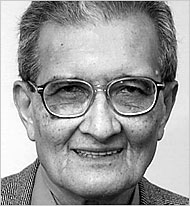| Want to send this page or a link to a friend? Click on mail at the top of this window. |
| Posted May 14, 2006 |
| We Contain Multitudes |
| _________________________________ |
| A Nobel-winning economist argues that nobody has just one identity. |
| IDENTITY AND VIOLENCE | |
| The Illusion of Destiny | |
| By Amartya Sen. | |
| 215 pp. W. W. Norton & Company. $24.95. | |
| By KENJI YOSHINO |
MY first exposure to murder," the Nobel-winning economist Amartya Sen writes in "Identity and Violence," "occurred when I was 11." It was 1944, a few years before the end of the British Raj and a period of widespread Hindu-Muslim riots. The victim was "a profusely bleeding unknown person suddenly stumbling through the gate to our garden, asking for help and a little water." Rushed to the hospital by Sen's father, the man died there of his injuries. He was Kader Mia, a Muslim day laborer knifed by Hindus. He had been asked by his wife not to go into a hostile area of then-undivided Bengal. But he had to feed his starving family, and he paid with his life.
 |
Jon Chase |
To the young Sen, this event was not just traumatic but mystifying. How was it, Sen asks about that murderous year, that "the broad human beings of January were suddenly transformed into the ruthless Hindus and fierce Muslims of July"? And how was it that Kader Mia would be seen as having only one identity — that of being Muslim — by Hindus who were, like him, out in the unprotected open because they too were starving? "For a bewildered child," Sen remembers, "the violence of identity was extraordinarily hard to grasp." And, he confesses, "it is not particularly easy even for a still bewildered elderly adult."
Sen's book argues for the reasonableness of that bewilderment. He takes aim at what he calls the " 'solitarist' approach to human identity, which sees human beings as members of exactly one group." This view, he argues, is not just morally undesirable, but descriptively wrong. While "a Hutu laborer from Kigali may be pressured to see himself only as a Hutu and incited to kill Tutsis . . . he is not only a Hutu, but also a Kigalian, a Rwandan, an African, a laborer and a human being."
The 'violence of identity' was hard for Sen to grasp when he was a child - and it still is. |
The originality of this critique is that it eschews trite appeals to the common humanity of those in savage conflict. Instead, Sen invokes the myriad identities within each individual. Because all of us contain multitudes, we can choose among our identities, emphasizing those we share with others rather than those we do not. Sen acknowledges, as he must, that such choices will be limited by external circumstances. Still, to concede that identity choices are constrained is a far cry from the claim that identity is destiny.
In a related vein, Sen criticizes the solitarist approach to civilizations. Influential texts like Samuel Huntington's "Clash of Civilizations and the Remaking of the World Order" take a drubbing for assuming monolithic Western and Eastern civilizations. With charming erudition, Sen demonstrates that things usually ascribed to one culture in fact often arose in another. Vindaloo, now seen as a quintessentially Indian dish, originally derived from chilies brought from Portugal, while the trigonometric sine function, assumed to be a European discovery, came from India. (An unequal exchange if ever there was one.)
FOR all its urbanity, however, "Identity and Violence" neglects what others will take to be common sense. Hutus and Tutsis will not lay down arms because they are told they are Kigalians, laborers or human beings. Sunnis and Shiites will not be coaxed into a group hug by a reminder of the religion and cultural attributes they share. The strength of Sen's argument lies in its intuitive nature: "In our normal lives we see ourselves as members of a variety of groups." Its weakness lies in its failure to explain why, at critical junctures, we disown that knowledge. Is it because human cognition tends to trade in binaries? Is it because violence creates identity as much as identity creates violence? Is it because human beings fear the choices or solitude a more cosmopolitan outlook would force them to face? These and other possibilities go unexamined.
To be sure, Sen's apparent na´vetÚ seems of a piece with his characteristic optimism about the human condition. This foray into identity and culture will seem a new departure for a scholar best known for his contributions to economics. But in all his work Sen has insisted that human beings are not simple. As early as 1977, he assaulted the concept of homo economicus, the individual who acts only in his narrow self-interest. And the complications he stresses point in a hopeful direction, revealing the extent to which actual people are guided by the claims of others.
In giving human complexity its due, Sen has always been a theorist of identity politics, even before the phrase became fashionable. The story of Kader Mia surfaces throughout his corpus as a seminal event of his childhood; "Identity and Violence" is simply the work in which he most directly confronts that memory and its implications. In doing so, he embodies his thesis, showing that one can be a Nobel winner, a secular saint and a writer who, for good and ill, retains a child's faith in our human natures. Kenji Yoshino, a professor at Yale Law School, is the author of "Covering: The Hidden Assault on Our Civil Rights."
Copyright 2006 The New York Times Company. Reprinted from The New York Times, Book Review, of Sunday, May 14, 2006.
| Wehaitians.com, the scholarly journal of democracy and human rights |
| More from wehaitians.com |